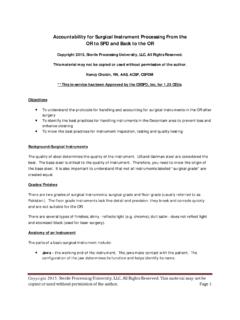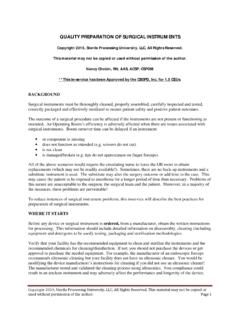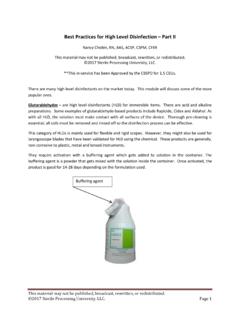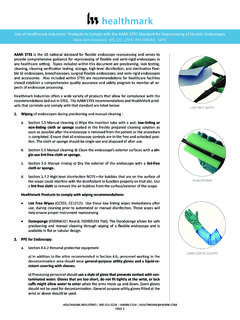Transcription of Wet Packs- Causes and Solutions - spdceus.com
1 Copyright 2015, Sterile Processing University, LLC, All Rights Reserved. This material may not be copied or used without permission of the author. Page 1 Wet Packs- Causes and Solutions Copyright 2015, Sterile Processing University, LLC, All Rights Reserved. This material may not be copied or used without permission of the author. Nancy Chobin, RN, AAS, ACSP, CSPDM **This in-service has been Approved by the CBSPD, Inc. for CEUs. Objectives To define wet packs and wet loads To review the major Causes for wet packs/loads To discuss investigations and troubleshooting methods for resolution of wet packs History Steam sterilization is the most common form of sterilization used today in both hospitals and Ambulatory Surgery Centers. Over the years many things have changed with steam sterilization and consequences have resulted.
2 When steam sterilizers were first approved, the type of packaging material used was muslin - which was relatively easy to dry. Instrument sets were comprised of basic instruments and weighed about 16 pounds. Healthcare changed to disposable wraps, first crepe paper, then plastic based wrap, then rigid containers. With the change in larger, heavier sets (especially Orthopedic sets) and the newer wrapping materials, sterile processing personnel have seen an increase in wet packs. Most newer packaging materials, especially heavy duty wraps and some plastic containers, make drying the contents more difficult. Most rigid container systems recommend a minimum 30 minute dry time because of this fact. What is a Wet pack ? Any pack which is still wet after sterilization and drying is considered wet.
3 There are three possible scenarios; visible moisture on outside of packs; moisture inside pack ( moist towel) or visible water inside the set/tray. When multiple wet packs are found in the same load, the load is referred to as a wet load. A wet load could be symptomatic of a steam problem; however, a full investigation should take place. Wet packs represent one of the greatest problems in sterility maintenance. Both the Association of peri-Operative Registered Nurses (AORN) and the Association for the Advancement of Medical Instrumentation ( aami ) recommend against the use of an item that is wet or a set that contains visible moisture, even if it is inside a rigid container (ANSI/ aami ST-79; AORN). Copyright 2015, Sterile Processing University, LLC, All Rights Reserved. This material may not be copied or used without permission of the author.
4 Page 2 Wet Loads When multiple wet packs are found in the same load, the load is referred to as a wet load. A wet load could be symptomatic of a steam problem; however, a full investigation should take place. Wet packs represent one of the greatest problems in sterility maintenance. Both AORN and aami recommend against the use of an item that is wet or a set that contains visible moisture, even if it is inside a rigid container (ANSI/ aami ST-79; AORN, 2011). Causes of Wet Packs The first reaction is to think there is a problem with the steam? It is important to understand that when room temperature metal instruments come in contact with hot steam, condensate will form. The colder the instruments and the more mass of metal, the greater the amount of condensate. Too much condensate may result in a wet pack at the completion of the drying cycle.
5 Other Causes of Wet Packs Improper packaging how was the set packaged? Was the wrapper too large (traps condensate inside set)? Was the package taped too tightly (traps condensate inside package)? Improper loading of sterilizer sterilizers should never be overloaded. There should be sufficient space between items to allow for steam to permeate around the package. Would You Expect Wet Packs? Copyright 2015, Sterile Processing University, LLC, All Rights Reserved. This material may not be copied or used without permission of the author. Page 3 PHOTO ABOVE: Would You Expect Wet Packs here? (Sets too close together, some overlapping) PHOTO ABOVE: Peel packs stacked, trays overlapping Generally, you should leave sufficient space between packs/sets to permit air removal and steam penetration.
6 There should be about one inch of space between each tray and rigid container. Proper spacing enhances drying. Linen packs should be placed on edge. If sterilizing multiples of the same type ( towel packs), you should be able to fit your fist between the packages; if not, they are loaded too tightly. Metal items in a mixed load (linens and metal goods) metal items should be on bottom and peel packages and linens on top. Rigid containers Stacking should not be performed unless the container manufacturer gives specific information on this process. Place containers beneath other items since they produce condensate. Copyright 2015, Sterile Processing University, LLC, All Rights Reserved. This material may not be copied or used without permission of the author. Page 4 PHOTO ABOVE - How Many Things Wrong Here?
7 Peel packs under sets, sets loaded on their side instead of flat Solid Mayo trays (including those with small holes) must be placed on edge to permit condensate to fall off. They should be tilted in proper direction (tilted forward so condensate does not collect in the lip of the tray). Mesh bottom baskets (wrapped) should be placed flat on the sterilizer cart. Paper-plastic pouches should be placed on their edge in a paper-plastic pouch separator or basket. If a basket is used, run your hand over the packages; they should move freely. Basins and other items that could retain water place on their side (edge) so condensate can run out. Set configuration How was the set assembled? Was there a large amount of metal mass (instruments) in one location instead of the instruments being evenly distributed on the set?
8 Were high density items ( weighted vaginal speculums) wrapped in absorbent material to help reduce condensate? Weight of trays - Most steam sterilizers were validated to sterilize and dry 16 pound sets. When we exceed that weight, problems can develop in drying the excess condensate that forms. aami now recommends that Orthopedic loaner sets weigh no more than 25 pounds including the container. All other sets should not exceed 25 pounds without the container. Copyright 2015, Sterile Processing University, LLC, All Rights Reserved. This material may not be copied or used without permission of the author. Page 5 Rigid containers add metal mass and weight to sets. Most container manufacturers recommend a 30 minute dry time to compensate for this. Some containers are made of plastic. Plastic is not as good at retaining heat as metal so the drying may not be as good in a plastic container as a metal one.
9 What weight limit did your container manufacturer recommend; 16-25 pounds of instruments for the inside basket? Use of other materials on set - Some facilities place rolled towels on sets (to permit easy retrieval of the stringer of instruments). However, this is not recommended because it is difficult to dry a rolled up towel; it forms too many layers. The use of non-absorbent wicking materials can also contribute to wet packs. This includes using disposable wrap inside trays (this is also prohibited because you have placed twice the amount of packaging recommended), silicone mats (difficult to dry), etc. Other Causes Steam quality This needs to be evaluated by the Engineering Department Improper insulation of steam lines Malfunction of traps in the steam line or no traps in the steam line Malfunction of the drain check valve or no drain check valve Steam contact with a cold load Too much water in the steam produced at the boiler Insufficient drying time Incorrect sterilizer installation Incorrect type of container (material, weight, design) Noncompliance with environmental controls for the preparation and packaging area Incorrect environmental conditions in the cool-down area ( , incorrect location of air conditioning vents) Removal of Items From the Sterilizer Items/packs removed from the sterilizer should be visibly dry.
10 If moisture is noted on top of the packages, it is probably due to condensate from the autoclave rack. It is recommended to line the autoclave cart with absorbent cloths which usually resolves this. The cloths should be changed each shift. Copyright 2015, Sterile Processing University, LLC, All Rights Reserved. This material may not be copied or used without permission of the author. Page 6 PHOTO ABOVE - Moisture On Outside of Set After Sterilization Avoid directly touching items while hot (a minimum of 30 min to 2 hours or more). It is also important to remember that steam vapor remaining in packs can cause condensate to form so items should not be handled before cooled. In Ambulatory Surgery Centers where autoclave racks are not usually used, this presents problems because the items need to be removed so another cycle can be run.














